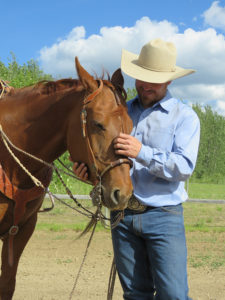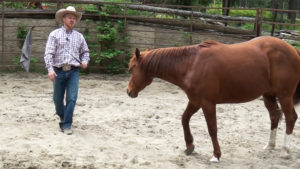In the past handful of posts, we’ve looked at several different styles of horsemanship — Emotional, Dictatorial, and Mechanical — which are based on different interpretations of the way horses think and behave. Today, I would like to give you a look at my own style of working with horses, which I call “Relational Horsemanship” because it focuses on the creation and maintenance of a balanced, positive, and mutually beneficial relationship between the horse and the human.
Relational Horsemanship steers away from the common emphasis on dominance and submission, instead of seeing the horse as a being whose thoughts and feelings have true value. In order to realize that value, communication with our horses must be a two-way street. Therefore, instead of being dictators, we need to become keen listeners, always seeking to hear and understand what our horses are continually telling us. Only in this way can we fulfill our primary relational responsibility to the horse, which is to meet their needs.
The study of psychology tells us that human relationships are need-based, meaning that we form relationships with other people because we have social, physical, and other types of needs we cannot satisfy if we are alone. Horses, being social animals, are very similar. Like people, horses are most content when their needs are being met, and they will form the closest relationships with those who help them maintain a high level of contentment.
Relational Horsemanship is therefore about striving to understand, evaluate, and meet the horse’s needs in order to form a meaningful relationship with them. When we make this a constant priority, we create a foundation of trust and connection that allows the horse to be a willing partner able to reach its full athletic potential. I consider this the basis of all good training and believe that it should inform every aspect of our work with horses.
If we use this Relational Horsemanship concept as the “filter” through which we interpret the horse, we start to see that that the horse’s actions and thoughts all stem from either met or unmet needs. This means that our first priority must be to understand what the horse’s needs are at any given time. Generally speaking, the horse’s needs are constant and universal. Beyond the basics of food, water, shelter, and companionship, their deepest need is to feel at peace, which means being comfortable in both mind and body. Anything that unsettles them, either mentally or physically, can cause them to struggle, as it is their nature to flee or resist any threat to their well-being.
It is our job, as the leader, to strip away the fears and uncertainties that create worry in the horse, and to help them attain a state of peace that carries through whenever we are present, and in everything, we ask them to do. We can achieve this by working with what I think of as the three pillars of training: Mind, Space, and Pressure.
The Mind of the horse is often neglected or ignored, especially in styles of horsemanship that focus on making the horse’s body do this or that. When we understand that the mind of the horse is what controls the horse’s body, and we shift our focus to communicating with the mind, great changes start to happen. By helping the horse’s mind understand and feel okay with our requests, we bring peace to the horse instead of creating fear and tension. They will then give their body over to our requests softly and willingly, instead of us having to take it from them in a state of struggle and resistance. The difference this creates – not only in how they feel about life, but in how they move, respond, and carry themselves – is something truly beautiful to behold.
In order to communicate with the horse’s mind, we need to make good use of the medium of Space. Horses “talk” to each other in many ways, but one of their main forms of conversing is through spatial interactions. Horses can claim, hold, yield, or share space, all of which form a language we can learn and utilize, enabling us to interact meaningfully with our horses and allowing them to understand what we want from them. From a Relational Horsemanship perspective, spatial interplay with our horses is not an exercise in dominance, but rather a means to establish clarity and understanding that builds connection.
Pressure is probably the most misunderstood and misused of the three pillars. All too often, pressure is used to push or force a horse to do something, rather than as an energetic conduit through which we can communicate with the horse. When used in a relational manner, the function of pressure is to modulate the conversation of space – much like our tone modulates our voice when we speak. And, in the same way, that your tone of voice can vary from calm and inviting to harsh and threatening, the tone of your pressure can also vary. We tend to think of pressure as something to drive the horse and move it away from us, but used relationally, pressure can also be used to draw the horse’s mind and body to us – something many people find surprising in my clinics.
By showing us how to communicate and build connection through the pillars of mind, space, and pressure, Relational Horsemanship allows us to meet our horses’ needs, create a living atmosphere of peace, and form a deep bond with these amazing beings who are so willing to give if we simply stop trying to take.

Horses form the closest relationships with those who help them maintain a high level of contentment, so if we show them that we can meet their needs, they are more than willing to bond with us.

Pressure, used in a relational context, is a form of communication that helps the horse to read our intention, not something we use to threaten the horse into doing what we want. People are often surprised to see that I use pressure as much to draw the horse to me (as I’m doing in this photo) as to move the horse away.

Beautifully articulated and oh so true! To experience the difference in the way a horse is able to interact with you in a relational way is magical. I’ve had ample experience in less than ideal relationships with horses. It is so wonderful to experience such a positive way of being with them.